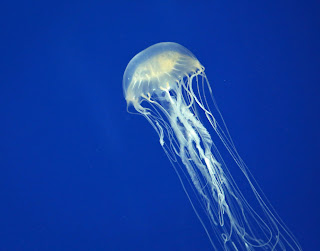Jellyfish are
fascinating. I hadn’t realized as much until my eyes were opened reading Spineless by Juli Berwald.
Part-memoir, yet chockfull of scientific facts, Berwald takes you around the
world in her quest to consume all things jellyfish. Yes, she even decides she
has to try cooking and eating some! The subtitle of the book is The Science of Jellyfish and the Art of
Growing a Backbone. I found it even harder to put down then the excellent I Contain Multitudes by Ed Yong, and
read multiple chapters in a single sitting. I will just highlight one of them.
Chapter 7 is
titled Seeing What’s Not There. Having
pondered Invisibility Rings and Making Visible the Invisible in chemistry, this chapter was particularly fascinating. Yes, it’s about jellyfish
transparency – but there are many other equally fascinating denizens of the
deep highlighted by Berwald. The tale of transparency begins with her
interviewing the jellyfish scientist, Richard Harbison, asking him why so many
jellyfish are transparent. His response: “The question is, why isn’t everything transparent?”
Berwald ponders
this question and writes: “In the ocean, with nothing to hide behind and
nothing to blend into, being opaque puts you at risk of being seen. Being seen
means being eaten. Invisibility is also an advantage if you are a predator.
Prey are more likely to steer clear if they can see you. Prey might just
stumble into your grasp if they can’t. Transparency is an underwater
invisibility cloak; the ultimate disguise.”
Posing Harbison’s
question to another scientist, Sonke Johnson, comes the reply: “because it’s
hard.” A surface-dwelling creature only needs to blend into its surroundings; a
“surface paint job” might suffice. But for an ocean roamer, one needs to do
much better. Berwald writes: “Some animals do this by being extraordinarily thin.
Light passes through such animals so easily that it encounters almost nothing
to scatter it. One supermodel of transparency is a comb jelly called the Venus
girdle, which is less than an inch thick, but can stretch a yard and a half in length.
The animal’s svelteness decreases scattering so much that in photographs it
looks like just a few white lines dashed off by a sketch artist.”
Berwald
anticipates the reader’s next question. “But many jellyfish aren’t flat; they
are bulbous round things.” Having previously discussed jellyfish locomotion and
buoyancy powered by its amazing mesoglea,
it turns out that “watery mesoglea is a brilliant solution to being transparent…
[because] light passes through the mesoglea nearly the same way it passes
through the ocean.” Berwald just has a way with words. “Jellyfish are physically
fat and optically skinny.” But there’s more. “And being physically rotund
matters a lot more in the open ocean, where there’s nowhere to hide, because
even the best invisibility cloak isn’t perfect… [If] spotted by a predator, it’s
always better to have heft on its side. No one wants to tangle with a big dude.
The mesoglea allows a thin jellyfish to masquerade as a jumbo version of
itself, and it does so on the cheap… jellyfish get a lot of heft, not for free
but at a significant metabolic discount.”
I’m essentially
quoting Berwald to give you a flavor of her engaging prose, and also because I
would do a lot worse trying to capture what she writes in my own clumsy
narrative. You’ll have to read the book (and it is a delight!) if you want to
know why the blood belly comb jelly has a currant-colored stomach. I also
learned that in Spanish, jellyfish is medusa.
And yes, Berwald appropriately weaves in the Greek mythology in her book. Jellyfish
might hold a clue to immortality. And their famed barbs are more sophisticated
than I could have ever imagined. (Below is the Australian Box Jellyfish,
picture taken from World Atlas.)
As for humans
living on a terrestrial surface terraformed into urban sprawls, a camouflage
cloak would have to be extremely sophisticated to mask the presence of its
wearer. A true cloak of invisibility, like the one handed down to Harry Potter
from his ancestors, would be a marvel indeed. The best we can do with our
modern optics and sensors is probably an invisibility shield. Several
variations have shown up in movies featuring hi-tech gadgets. But in the realm
of the merpeople, a hi-tech invisibility wetsuit would be within reach. Then
again, it depends on who’s looking and how they are looking. Not every creature
exploits the visual, especially if there’s little light in the depths.
In any case, I am
looking forward to my next visit to an aquarium. Having read Berwald’s
fantastic book, I will never look at jellyfish the same way again. I’ll be
spending time looking a lot closer and harder, to see what I had not seen
before!


No comments:
Post a Comment